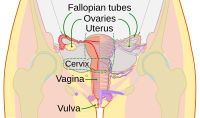
Photo from wikipedia
The understanding of changes in the viscoelastic properties of cervical tissue during the gestation process is a challenging problem. In this work, we explore the importance of considering the multilayer… Click to show full abstract
The understanding of changes in the viscoelastic properties of cervical tissue during the gestation process is a challenging problem. In this work, we explore the importance of considering the multilayer nature (epithelial and connective layers) of human cervical tissue for characterizing the viscoelastic parameters from torsional waves. For this purpose, torsional wave propagations are simulated in three multilayer cervical tissue models (pure elastic, Kelvin-Voigt (KV) and Maxwell) using the finite difference time domain method. High-speed camera measurements have been carried out in tissue-mimicking phantoms in order to obtain the boundary conditions of the numerical simulations. Finally, a parametric modeling study through a probabilistic inverse procedure was performed to rank the most plausible rheological model and to reconstruct the viscoelastic parameters. The procedure consist in comparing the experimental signals obtained in human cervical tissues using the Torsional Wave Elastography (TWE) technique with the synthetic signals from the numerical models. It is shown that the rheological model that best describes the nature of cervical tissue is the Kelvin-Voigt model. Once the most plausible model has been selected, the stiffness and viscosity parameters have been reconstructed of the epithelial and connective layers for the measurements of the 18 pregnant women, along with the thickness of the epithelial layer.
Journal Title: Journal of the mechanical behavior of biomedical materials
Year Published: 2020
Link to full text (if available)
Share on Social Media: Sign Up to like & get
recommendations!